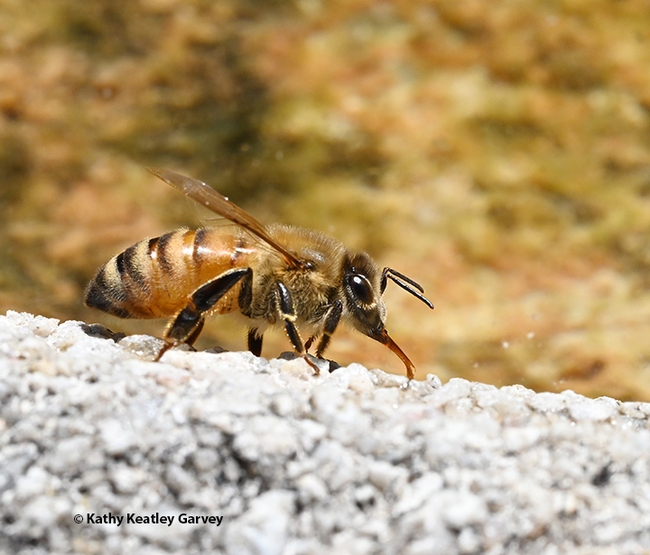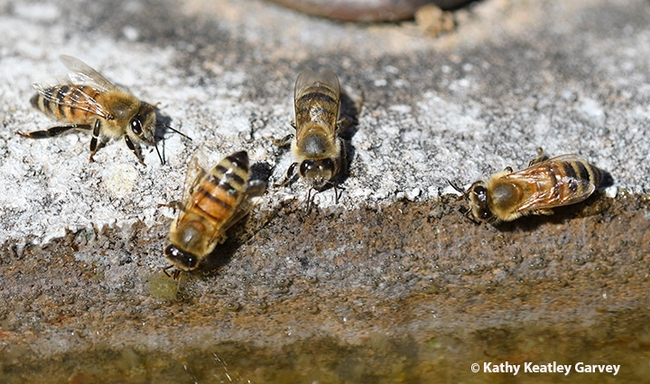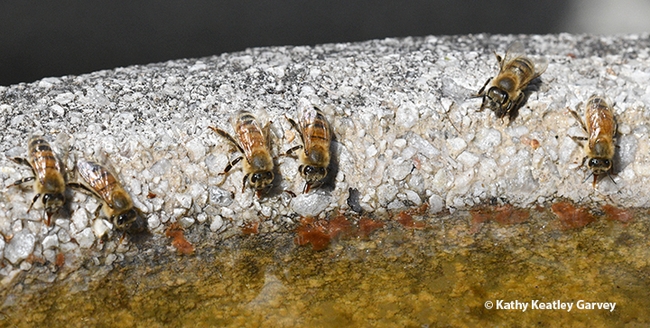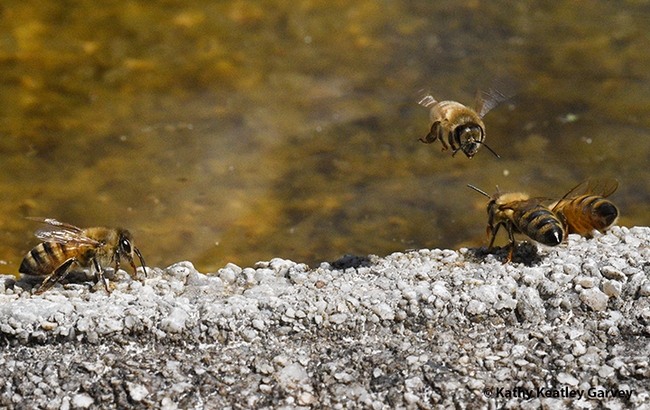If you're struggling with triple-digit temperatures, think about the honey bees.
They need to collect water for their colony to cool the hive so their brood can develop. And for other purposes.
Just call them "The Water Girls."
Lately the bees have taken a liking to our birdbath. The birds? They're practicing social distancing.
We remember Extension apiculturist Eric Mussen (1946-2022) telling us "Like most other animals, the bodies of honey bees are mostly water. Thus, they need to drink water routinely as we do. Additionally, water (or sometimes nectar) is critical for diluting the gelatinous food secreted from the head glands of nurse bees, so that the queen, developing larvae, drones, and worker bees can swallow the food. They use water to keep the brood nest area at the proper relative humidity, especially when it gets hot and dry outside the hive. Water droplets, placed within the brood nest area, are evaporated by fanning worker bees and that cools (air conditions) the brood nest area to keep the eggs and developing brood at the critical 94 degrees Fahrenheit required for proper development."
Unlike us, honey bees cannot simply turn on a faucet. "They will fly up to nearly five miles to find a suitable watering source," Mussen told us back in 2014. "Suitable to honey bees might not be suitable to us, but if it is moist, it may be visited. Suitable to the neighbors is a separate question. Honey bees can become quite a nuisance if they visit drippy irrigation lines or hose connections, birdbaths, pet water dishes, swimming pools, fountains, or wet laundry and the like. The water foragers become habituated to those sites. If you try to dissuade the bees by drying up the source for a while, it becomes evident that the bees will visit the site every so often so they'll be around quickly after the water is returned."
What to do? "People have tried to use repellents in the water, but the bees are likely to use the odor as an attractant when attempting to relocate the water source. Some people have had success keeping bees and wasps out of their swimming pools with very lightweight oils or monomolecular films--their purpose is to prevent mosquitoes from being able to breathe. But, if the water is splashed very much, you'll require a new layer."
And all those bees struggling in your swimming pool? "Not all moribund honey bees in a swimming pool are there because they were trying to get a drink. Every day, approximately 1,000 old honey bees from each colony die naturally. This normally occurs during foraging, and the bees just flutter down to the ground, sidewalk, driveway, parking lot, or whatever they were passing over. Some flutter into swimming pools. They are not dead, yet, so they can and do inflict stings on people who bump into them on the surface of the water. "
Beekeepers should make sure there's a watering source on their property so the bees won't hunt for water elsewhere, Musssen pointed out. It should be available all year around. "Once the bees are habituated to the site, most of them will use that source."
It's also a good idea to place corks in a birdbath for the bees to stand on. Bees don't like to get their feet wet. And if they drop into the water structure, they can drown.
As for the bee tenants in our watering hole, bring 'em on.
We absolutely love "The Water Girls." The birds, well, not so much. (But they do have access to a second birdbath and a fish pond.)
Attached Images:

A honey bee, its proboscis extended, collects water from the edges of a birdbath. (Photo by Kathy Keatley Garvey)

For worker bees: Two's company, three's a crowd, and four is a work party. Bees collecting water from a birdbath. (Photo by Kathy Keatley Garvey)

'The Water Girls'--six of them--collecting water at a Vacaville birdbath. Note the absence of birds. (Photo by Kathy Keatley Garvey)

A honey bee heading back to her colony after collecting water to cool down the hive. (Photo by Kathy Keatley Garvey)